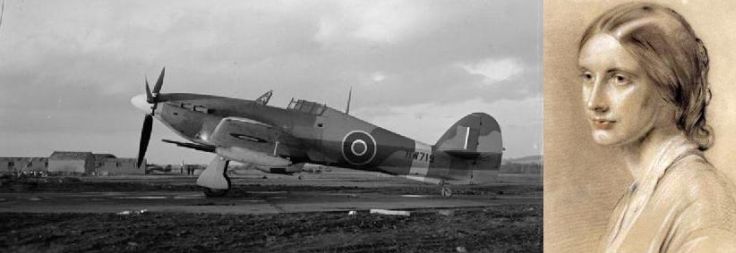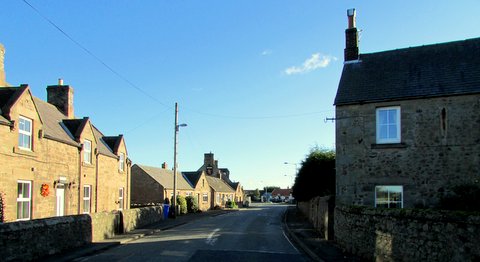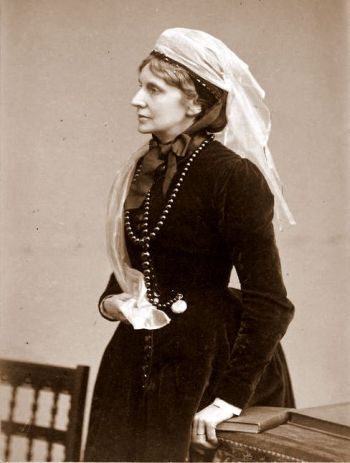Milfield is situated about six miles north-west of Wooler on the A697, alongside the River Till, and it lies within the parish of Kirknewton. It is the likely location of Maelmin, mentioned by Bede, and once the site of a royal residence for the kings of Bernicia. It is close to the site of the mediaeval Battle of Homildon Hill and a World War II airfield training station; it was home to many generations of the Grey family of Milfield Hill, and it was the birthplace of the social reformer Josephine Butler.
The village stands at the foot of the Cheviot hills and at the edge of the fertile area of the Milfield plain. Milfield is surrounded by sites of historical interest ranging from pre-historic times to the 20th century.
Archaeology of the Cheviot Quarry
Cheviot Quarry, just south of Milfield, is owned by Tarmac Construction, who in recent years commissioned a series of archaeological investigations there. Spectacular discoveries were made which include three phases of settlement dating from the Neolithic, the Late Bronze Age and Dark Age periods. The following account of findings there is reproduced (with grateful acknowledgment) from the website of Archaeological Research Services:
“Neolithic hearths, storage pits and post holes were discovered across the site, and in two distinct clusters, containing large quantities of stone tools, pottery, charred wood and other plant remains. The pottery included large sherds from Early Neolithic Carinated Bowls as well as Later Neolithic Grooved Ware. The stone objects included a variety of flint blade tools such as knives and scrapers, together with a roughout of a carved stone ball, a whetstone and a hammerstone for flintknapping.
“The two circular houses encountered were dated to the Late Bronze Age (c.1000-870 BC). These were post-built houses which all had an entrance way facing south east towards the rising sun and were associated with a large amount of ‘Flat Rimmed Ware’, a type of pottery dating from this period. The occurrence of identifiable Later Bronze Age houses in the valley bottom is of importance as there is a paucity of evidence of what happens in settlement in the Late Bronze Age following an abandonment of the uplands in the 12th century BC.
“The three rectangular houses were dated to the ‘Dark Age’ or British period and are very likely to pre-date the documented Anglo Saxon conquest of the area in the years around AD 547. This is again an important discovery as there is very little archaeological or documentary evidence for what this area was like during the time between the Roman and Anglo Saxon periods.”
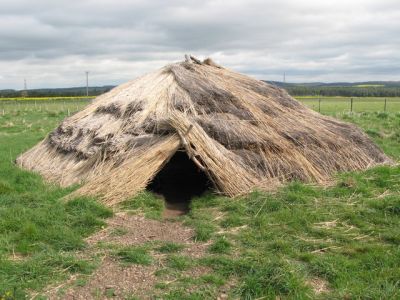
Maelmin – reconstruction of Mesolithic hut. This reconstruction is of a Mesolithic hut excavated in the summers of 2000 and 2002 at Howick on the Northumberland coast. Photo: Lisa Jarvis, CC-BY-SA-2.0, via Wikimedia Commons.
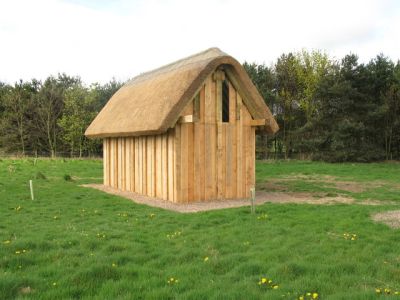
Maelmin – reconstruction of ‘dark age’ hall based on the excavations held at Cheviot Quarry in 2005. Photo: Lisa Jarvis, CC-BY-SA-2.0, via Wikimedia Commons.
The Maelmin Heritage Trail has been established on the southern edge of Milfield village (signposted from the A697). Here you can visit a full-size reconstruction of an Anglo-Saxon timber-built building that was excavated at Cheviot Quarry. Entrance is free and access is available during daylight hours. Further details and site leaflets can be obtained from the information point in the village café, and there is a website at: www.maelmin.org.uk
Mediaeval conflict
Milfield stands in the middle of an area which saw two of the major battles between the English and the Scots during the mediaeval period.
The Battle of Homildon Hill (known today as Humbleton Hill, about 4 miles south-east of Milfield) took place on 14th September 1402. In August, a Scottish army of several thousands led by the Earl of Douglas had taken advantage of the insecurity of the recently crowned Henry IV to make an expedition into England as far as Newcastle. As they retreated, slowed down by plunder, they found their path blocked at Milfield by the forces of the Earl of Northumberland and his son Henry Percy, better known as Hotspur. The Scots camped in a strong position on Homildon Hill, but the English were able to inflict heavy casualties upon them by the use of archers.
An account of the battle, with pictures of the terrain, can be found on the website of the UK Battlefields Resource Centre.
Another description of the battle was given by William Whellan in his History, Topography and Directory of Northumberland (1855), pp.704-705, available online at the Internet Archive.
A still more momentous battle was fought a century later at Flodden which lies around 3 miles north-west of Milfield; on 9th September 1513, the Scottish army of James IV which had invaded Northumberland engaged with English forces led by the Earl of Surrey after finding itself cut off from retreat northwards. Follow the link for more on the Battle of Flodden.
World War II
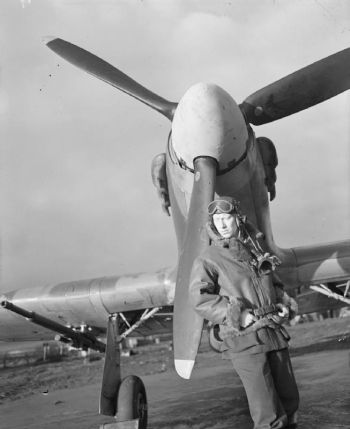
Squadron Leader James Lacey DFM standing by the propeller of a Hawker Hurricane at Milfield. © IWM (CH 8459) (Imperial War Museum).
RAF Milfield was built during 1941 and 1942 (just south of Milfield village beside the A697) to serve as an airfield training unit for pilots. Originally intended as a bomber operational training unit (OTU), its final status was as a fighter operational training unit.
Around 2000 personnel were stationed at RAF Milfield, including airmen and airwomen, officers and NCOs. They were accommodated in ‘site houses’ scattered around various parts of the airfield, in order to minimize casualties in case of attack.
Training began in August 1942. The courses ran for a period of 9-10 weeks with the aim of turning out thirty pilots every three weeks. The first 5-6 weeks were spent preparing the pilots for basic solo flying on Hurricanes; they would then move on to RAF Brunton, near Edinburgh, for another 3-4 weeks of flying Hurricanes in formations and simulated combat conditions.
The pilot students, who came from the allied countries of America, Canada, South Africa, Australia, New Zealand and the UK, had already received training under the 1939 British Commonwealth Air Training Plan and had an average of 130 hours of basic and service flying before coming to RAF Milfield. Because of a degree of disparity in the flying training standards and weather conditions within the countries operating the plan, the need was recognised in 1940 to standardise training on the aircraft the students would be going on to fly at squadrons operating within Europe, and so OTUs such as the one at Milfield were set up to provide this important standard.
A low attack training school was also formed at RAF Milfield which taught the fighter bomber role to the pilots. These pilots eventually went into action to play a decisive role in ‘Operation Overlord’ and in WW2 combat operations.
At the end of WW2 the Royal Air Force ended its association with RAF Milfield. However the airfield has found a contemporary use as the base for the Border Gliding Club.
Sources:
Abandoned & Little-known Airfields: Milfield (website)
Milfield, not just an airfield… (website)
North East Aviation Research
North East Aviation Research is the official research and archive of the North East Aircraft Museum. For those wishing to research aircraft loses in the North East from 1910-to date, their website provides a valuable record, providing dates, types of aircraft, serial number, squadron and location. To view the page covering loses over the North East click here: http://www.nelsam.org.uk/NEAR/Losses/Losses.htm
Josephine Butler
Milfield was the birthplace of Josephine Butler, one of the 19th century’s leading feminists and social reformers.
She was born Josephine Elizabeth Grey at Milfield Hill on the 13th April 1828, the fourth daughter and seventh child of John Grey, a cousin of Earl Grey. As a member of a wealthy and prominent family, she was educated largely at home, and she was strongly influenced by her father’s passion for social reform and hatred of injustice. In 1852 she married George Butler, then a tutor at Oxford, in whom she found a like mind, and together over the course of their lives they supported the abolition of slavery, showed concern for the socially disadvantaged, and argued for better rights for marginalized women.
Living first at Oxford, and then at Cheltenham College, the Butlers moved to Liverpool in 1866 when George, now ordained, was invited to become the headmaster of Liverpool College, and they remained there until 1882. After the death of her husband in 1890, Josephine Butler settled in London and also travelled and campaigned in Europe. In the last few years of her life, she returned to Northumberland to live near her son in Wooler, where she died on 30 December 1906. She was buried in the churchyard at Kirknewton.
The following summary of aspects of her work is reproduced (with grateful acknowledgment) from the website of the Josephine Butler Memorial Trust
“[In Liverpool] still suffering from grief and from the depression which would recur throughout her life, Josephine threw herself into working with women in the local workhouse, hoping, as she wrote, to ‘find some pain keener than my own – to meet with people more unhappy than myself.’ She had no clear plan, other than to help: ‘my sole wish,’ she explained, ‘was to plunge into the heart of some human misery, and to say (as I now knew I could) to afflicted people, “I understand. I, too, have suffered.”‘ As a result of rescuing many young girls from the workhouse, and either finding them homes or taking them into her own household, Josephine worked to set up her own refuge, believing it to be a divine calling.
“Josephine Butler’s practical work fed into her own writing, and her first published article, The Education and Employment of Women, was followed by Women’s Work and Women’s Culture. In 1867, having met Anne Jemima Clough, sister of the poet A. H. Clough, she began campaigning for better educational provision for women, becoming president of the North of England Council for the Higher Education of Women. Despite her own ill-health, she also travelled to Cambridge to persuade the University to allow women’s admission to study there, and to set up a college (Newnham College) exclusively for women.
“After a tour of Switzerland in 1869, intended to improve her health, Josephine became aware of European policies designed to regulate prostitution, and of Britain’s own recently passed Contagious Diseases Acts of 1864, 1866, and 1869. These laws, which effectively legalized the sex trade, sought to control the spread of sexually transmitted diseases in the army and navy and required all women living near garrison towns and naval ports to submit to registration and regular internal examination. In 1870 Josephine became leader of the Ladies National Association for the Repeal of the Contagious Diseases Act, arguing against the presumption of guilt on the part of the women, and seeking instead both to question the morality of the men involved and to bring them to account for their behaviour. She travelled the country, speaking with incredible force and passion, sometimes putting herself in danger, surprising many with her candour on the taboo subjects of prostitution and sexual morality.
“[In Winchester in 1882] Josephine had soon opened up a new House of Rest for women who temporarily needed care and shelter, and continued her campaigning work, offending both Church of England members by her outspokenness, and atheists among the repeal movement by her strong faith. But Parliament did finally repeal the Contagious Diseases Acts in 1886, and laws which in effect also enslaved women into prostitution in Switzerland, Holland, Norway, France, and Italy were similarly repealed or reformed because of her influence.”
Additional information about her life and work can be found on the Josephine Butler page by Helen Mathers.
************************************************
The Grey Family of Milfield Hill
The Grey family, into which Josephine Butler was born, is the subject of an extensive website created by Claire Grey. It includes a fascinating range of family trees, documents, maps, and photographs of the family and their property. Click the image below to visit the website:
“Seven generations of the Grey family lived at Milfield Hill House. The first Grey to farm there was born in 1754 and its last owner died only a few years ago. The house was demolished in the 1960s, but family members remember it with affection. Their descendants are now living all over the world and this site is for them.”
************************************************
Berwick Record Office holds some papers relating to the Grey family of Milfield Hill (though not about Josephine Grey herself). These are mostly from the 18th and 19th centuries, and they consist of personal correspondence, financial records, title deeds and valuations of properties including Milfield Hill, and a number of copies of wills. [Reference no. NRO.496: 2 boxes]
***********************************************
Banner images: British aircraft of the Royal Air Force, 1939-1945: Hawker Hurricane: © IWM (CH 18135) (Imperial War Museum); and Josephine Elizabeth Butler (née Grey), by George Richmond; pastel, 1851. NPG 6482 (National Portrait Gallery, London).

